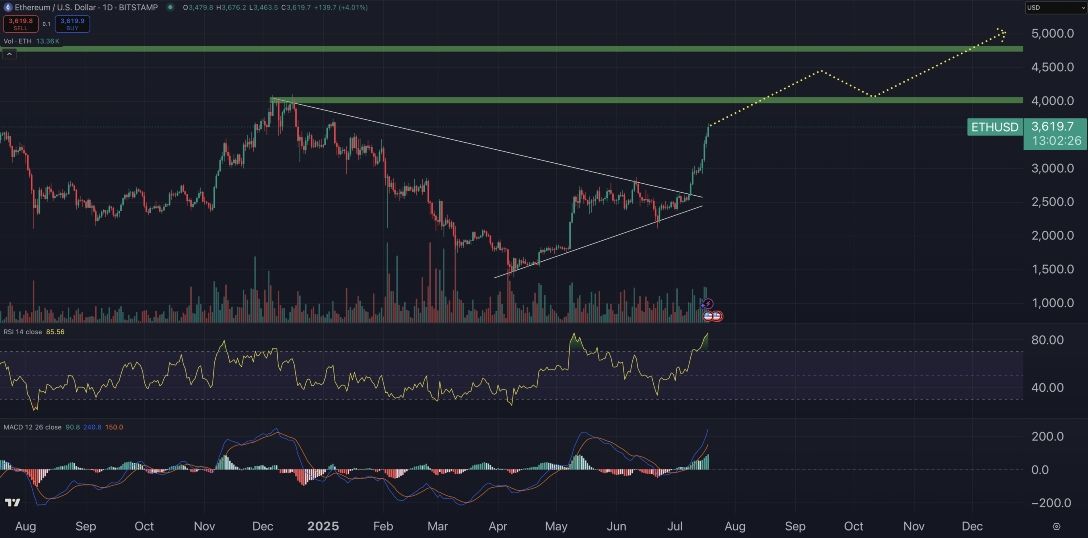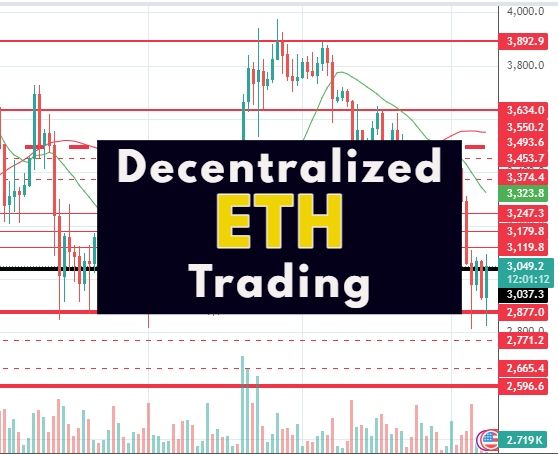Decentralized Ethereum (ETH) Trading. Discover the price zones to watch and the advantages of decentralized trading.
Decentralized Ethereum (ETH) trading, an excellent way to profit from and trade the rise and fall of the ETH price. Discover the advantages of decentralized ETH trading.
Decentralized Ethereum (ETH) Trading – the advantages:
Decentralized trading of Ethereum (ETH) is gaining traction in the digital finance world. Unlike traditional centralized trading platforms, decentralized exchanges (DEXs) offer a new way to trade digital assets, emphasizing transparency, security, and user autonomy. This article explores the key advantages of decentralized ETH trading.
1. Enhanced Security
Resistance to Hacks
DEXs operate without a centralized intermediary, significantly reducing the risk of hacking. User funds are not stored on a single platform but remain under the control of the owners in their private wallets. This structure minimizes vulnerabilities that hackers often exploit to attack centralized platforms.
Use of Smart Contracts
DEXs rely on smart contracts, autonomous programs executed on the blockchain. These contracts ensure the automatic and secure execution of transactions, eliminating the need for trust in a third party. Ethereum’s smart contracts are known for their robustness, further enhancing the security of exchanges.
2. Transparency and Verifiability
Open Source
Decentralized platforms are often open source, allowing anyone to audit the code. This transparency builds user trust, as the code can be reviewed to identify and fix potential vulnerabilities.
Blockchain Record
All transactions conducted on a DEX are recorded on the blockchain, providing complete traceability. Users can verify the history of all transactions, increasing transparency and reducing the chances of manipulation or fraud.
3. Autonomy and Control
Private Key Management
In a DEX, users retain control of their private keys. This autonomy prevents fund losses due to bankruptcies or malicious behavior by a centralized platform. Users are solely responsible for managing and securing their assets.
Global and Uninterrupted Access
DEXs operate without interruption, regardless of local regulations or technical issues with a central server. They are accessible at any time and from anywhere, offering greater freedom for traders worldwide.
4. Reduced Fees
Transaction Fees
Centralized exchanges often charge significant fees for transactions and withdrawals. By using a DEX, users can benefit from lower transaction fees, as there is no intermediary to charge additional fees.
No Deposit and Withdrawal Fees
DEXs allow users to deposit and withdraw funds directly from and to their private wallets without additional fees, which can represent significant savings, especially for frequent traders.
5. Diversity of Assets
Wide Range of Tokens
DEXs often offer a greater variety of tokens compared to centralized exchanges, including lesser-known or newly launched tokens. This diversity allows traders to find unique investment opportunities.
Quick Addition of New Assets
New tokens can be listed on DEXs much faster than on centralized platforms because there is no centralized approval process. This allows traders to access new market opportunities quickly.
Conclusion
Decentralized ETH trading offers numerous advantages over centralized platforms. Enhanced security, increased transparency, user autonomy, reduced fees, and asset diversity are among the key benefits attracting more and more traders to this new form of exchange. As the decentralized finance (DeFi) ecosystem continues to grow, DEXs play a crucial role in democratizing and securing cryptocurrency trading.
This generally impacts the ETH price:
Upcoming updates: The Ethereum network continues to evolve with updates such as the Shanghai update, which allows stakers to withdraw their ETH. These updates can influence market sentiment and the ETH price. Events such as a new ETF linked to ETH also influence the price.
Global economic factors: General economic conditions, including regulatory developments and macroeconomic trends, will also have an impact on ETH performance. Investors should keep a close eye on global economic news as well as the latest crypto news.
Technical analysis: Current technical indicators suggest bearish sentiment, with a significant level of market fear. However, some analysts foresee a potential rebound if key support levels are maintained. Find out more below.
Decentralized Ethereum (ETH) Trading – technical analysis (daily)

Here’s a technical analysis of Ethereum (ETH) based on recent price movements, key support/resistance levels, and overall market sentiment:
Ethereum (ETH): Technical and Fundamental Analysis
Recent Trends & Key Levels
In July 2025, ETH experienced a remarkable surge of over 48%, fueled by massive institutional inflows and very bullish technical signals.
The price broke through several critical levels, reaching as high as $3,812 on July 21st—its highest point since December 2024.
According to XTB analysis, Ethereum has already hit a target level at $3,675 and is now aiming for $4,000 if momentum continues.
Chart Patterns & Projections
A bull-flag pattern on the daily chart suggests a possible continuation toward $4,870, in line with a multi-year triangle formation.
Elliott Wave models indicate bullish potential up to $9,000 as early as the beginning of 2026.
Bravenewcoin forecasts a conservative target of $4,800 by the end of 2025, and up to $5,500 in early 2026, assuming a favorable macro environment.
Technical Indicators
The breakout above the resistance zone around $2,800–$2,900—especially through the 200-day EMA—confirms a firmly established uptrend.
The break through the $2,879–$3,083 zone (with a bounce off $2,879 support and a test of $3,083) signals a potential entry point into a wave 3 of a broader cycle.
ADX indicators (+DI > –DI, ADX ~30) show a strong bullish trend; however, the RSI hovering in overbought territory (RSI ~78–79) calls for caution regarding a potential short-term pullback.
Ethereum Technical Analysis Summary
Ethereum is currently displaying strong bullish momentum. The price has recently broken through several major resistance levels, notably the $2,800–$2,900 range, which had served as a technical ceiling for months. This breakout, coupled with a clean move above the 200-day EMA, confirms a resumed long-term uptrend. Key support levels to watch now lie around $2,940, and then at $2,750–$2,800 if a corrective pullback occurs.
The market recently tested the $3,800–$3,812 zone, a major short-term resistance. If this barrier is broken with strong volume, the next technical targets lie at $4,100, and up to $4,870 based on the bull-flag pattern identified on the daily chart. Some analysts even project bullish extensions toward $5,500 and beyond in the context of a developing Elliott Wave cycle.
Trend indicators like the ADX signal growing strength in the move, with buyers clearly in control. Meanwhile, the RSI is reaching overbought levels (~78–79), suggesting the need to closely monitor for any short-term consolidation, though this does not undermine the structural bullish trend.
In summary, Ethereum is in a powerful bullish cycle, supported by clear breakouts, high volume, and continuation patterns. However, caution remains warranted in the very short term due to signs of overheating. A potential pullback to previous support levels could offer strategic entry points before a possible move toward historically unprecedented price levels.
Ethereum – Fundamental Analysis:
Institutional Adoption & ETFs
The approval of Ether ETFs by the U.S. SEC triggered massive inflows, with over $10 billion accumulated in BlackRock’s ETHA ETF and $203 million/day flowing into Fidelity’s FETH.
The company The Ether Machine, born from a merger with Dynamix Corp, plans to raise $1.6 billion to manage 400,000 ETH in balance—marking Ethereum’s institutional leap onto Nasdaq (ticker: ETHM, Q4 2025).
Firms like BitMine, SharpLink, and others are implementing ETH treasury strategies (including staking), reflecting growing institutional interest in ETH as a yield-generating asset.
Network Developments and Upgrades
In March 2024, the Ethereum network underwent the Dencun upgrade, which included EIP-4844 (proto-danksharding), significantly reducing rollup transaction fees and boosting Layer 2 scalability.
The upcoming Pectra upgrade, expected mid-2025, expands staking capacity (32 to 2048 ETH) and enhances smart external accounts (EIP-7702).
These improvements support a reduction in circulating ETH supply, thanks to increased staking and higher network efficiency—resulting in medium-term deflationary pressure.
On-Chain Metrics
Currently, over 28% of ETH is staked, and exchange balances are at their lowest since 2016—strengthening bullish pressure via scarcity and rising demand.
Network activity continues to grow: DeFi and NFTs are thriving, and rollup usage is expanding—creating consistent demand for ETH as gas.
However, recent analyses highlight risks related to contract centralization (critical dependencies and mutable deployers now account for 50% of transactions).
⚙️ Macro & Regulatory Context
U.S. regulatory adoption, particularly the GENIUS Act, provides legal clarity for stablecoins, strengthening the legitimacy of platforms like Ethereum—especially in the DeFi/stablecoin ecosystem.
The Fed’s interest rate policy, with anticipated rate cuts, is boosting liquidity and appetite for risk assets like ETH.
Summary & Outlook
Why is ETH in a bull market?
-
Clear technical breakouts above $2,800–$3,000 zones, backed by volume and solid chart confirmations.
-
Massive institutional inflows via Ether ETFs and corporate treasury strategies.
-
Structural network upgrades (Dencun + Pectra) improving scalability and reducing circulating supply.
-
Growing stablecoin & DeFi adoption on an energy-efficient PoS network.
-
Recent U.S. regulatory clarity reassuring major players.
Price Targets
-
Short term (end of July): $3,300–$3,400, potentially up to $3,675–$3,800 if momentum holds.
-
Medium term (end of 2025): likely target between $4,100 and $4,800, possibly $5,000 if trend confirms.
-
Long term (early 2026): ambitious target around $5,500, or even $9,000 under Elliott Wave scenarios.
⚠️ Risks to Watch
-
Technical overbought conditions: High RSI could lead to temporary pullbacks.
-
Overextended speculative flows: Bull-flag pattern may consolidate before a new impulse.
-
Network or regulatory setbacks: High dependency on Layer 2 or tightening legislation could hinder momentum.
Overall Conclusion:
In July 2025, Ethereum (ETH) is experiencing an exceptionally favorable market phase, both technically and fundamentally. Signals continue to align in the same direction: a strong comeback driven by internal protocol dynamics, record institutional demand, and a chart setup conducive to a prolonged bull cycle.
Technically, breaking through critical levels like $2,800, $3,000, and then $3,800 confirms a solid uptrend. Chart patterns (bull-flag, long-term triangle) support a move toward even higher levels—potentially between $4,800 and $9,000 by 2026, based on certain projection models. This setup is reinforced by the ongoing reduction in liquid supply, growing network usage, and massive capital inflows through ETFs.
On the fundamental side, Ethereum is positioning itself as an institutional yield-bearing asset via staking, corporate treasuries, and new financial structures like Ether Machine. Regulatory and technological adoption is advancing rapidly—especially with recent upgrades like Dencun (lower fees and improved scalability) and the anticipated Pectra update, which will enhance staking flexibility and user experience.
All of this is unfolding in a favorable macro environment: expected Fed rate cuts, new U.S. regulations (notably around stablecoins), and rising confidence in Web3 assets.
In short, Ethereum isn’t just rebounding—it may be solidifying its role as the dominant infrastructure for decentralized finance, backed by strong fundamentals, continuous innovation, and a market recovery that could be here to stay.
Direct access to decentralized ETH trading
Community of experienced traders in the Forex, commodities and crypto markets, offering articles to help you learn about trading through: relevant information – technical and fundamental analysis. Specificity: specialized in decentralized trading.
Communauté de traders expérimentés sur les marchés du Forex, matières premières, cryptos, offrant des articles permettant de s’éduquer au trading à travers : information pertinente – analyse technique et fondamentale. Spécificité : spécialisé dans le trading décentralisé.
